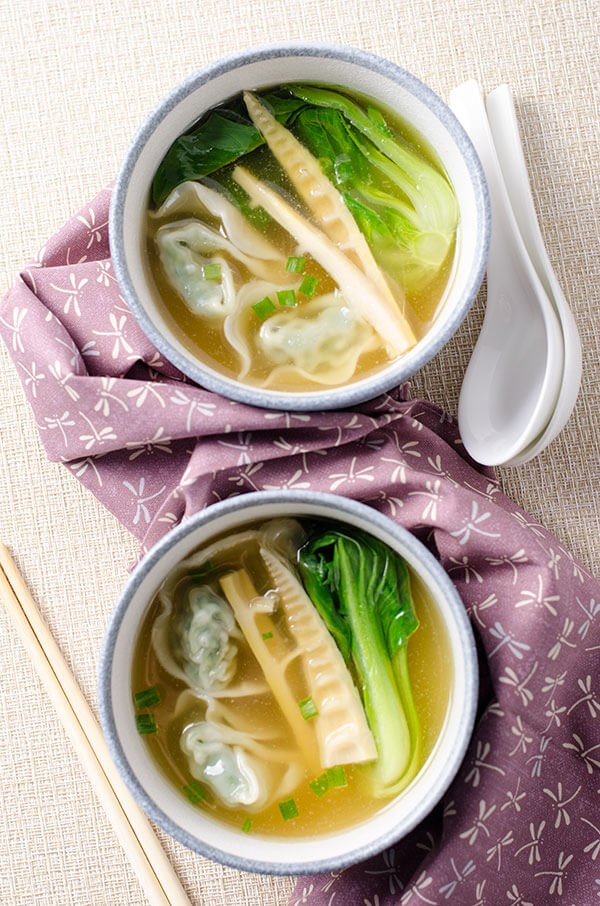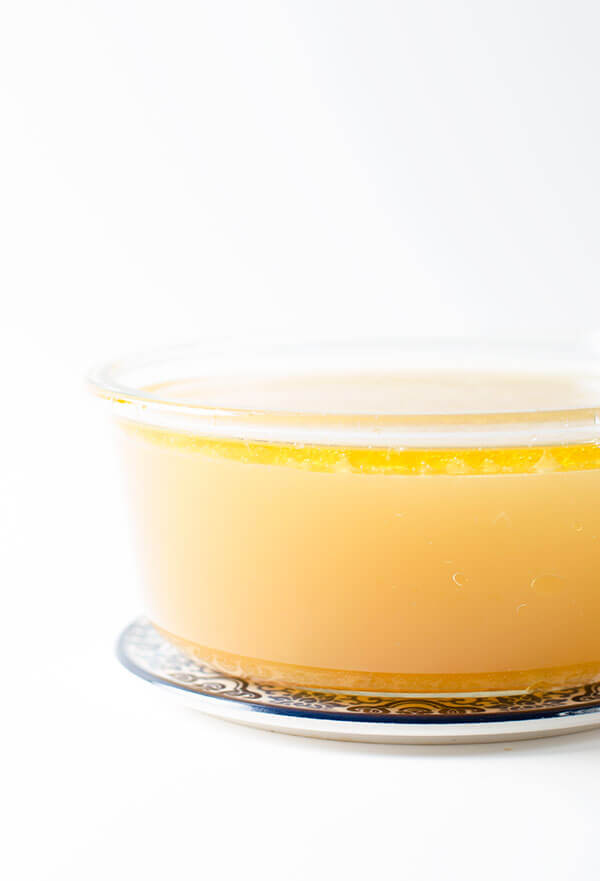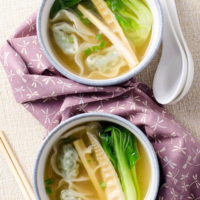
Chicken stock is one of the essential ingredients in Chinese cooking. It uses a minimal amount of fresh herbs, such as ginger and scallion, to bring out the flavor of the chicken without adding too much character to the stock. The finished chicken stock has a soothing aroma and a buttery texture.
Cooking chicken stock is a very common practice in Chinese cuisine, and I haven’t done enough of it. No matter whether for chicken noodle soup, wonton soup, or to be added into congee, homemade chicken stock adds a flavor far superior to that of canned stock and is free of additives.
Moreover, homemade chicken stock comes with a layer of chicken fat on top. Chicken fat is extremely useful as a cooking oil. If you ever make seafood tofu stew or Hainanese chicken rice with a spoonful of chicken fat, you will be surprised how a small amount of the grease goes such a long way and can turn a simple dish into a taste of heaven.

Different from a Western style chicken stock, homemade Chinese chicken stock usually uses a whole chicken, instead of a chicken carcass, with a few fresh herbs. The ginger and scallion help eliminate the unpleasant scent of the meat and bring out its flavor without adding too much noise to the stock.
To make stock with a more concentrated flavor, I usually choose a “free range old hen”. The meat of this kind of chicken contains more flavor, though its texture is much tougher than average. It will yield a richer stock and the meat won’t become too washed-out after many hours of simmering.
I used some dried jujubes and American ginseng in the recipe. It’s a Chinese habit to add nutrition-intensive fruits and herbs to chicken stock, which are considered healthy and have immune-boosting effects. If you’ve never used ginseng before, I strongly suggest you check out its benefits and side effects before using. The ginseng and jujubes add some depth to the flavor but don’t overwhelm it. Simply skip these ingredients if you cannot find them.
It might seem a bit daunting to cook a whole chicken, but the truth is, it’s surprisingly easy. I like to cook chicken stock on the weekend and use the broth and chicken meat over the course of the following week. You can use the stock in noodles, soups, stews or stir-fry. As for the leftover chicken meat, you can use it in a sandwich, salad or soup, or throw it into a stir fried dish. Try it once and you will find that it makes your weekday dinners much easier and tastier!


Chinese Chicken Stock
Ingredients
- 1 whole chicken or 1 frozen whole chicken, thawed
- 1/2 Chinese scallion 15 centimeters / 6 inches long, chopped into 4 pieces
- 1 thumb-sized piece ginger sliced
- optional 6 dried jujubes
- optional 1 piece dried American ginseng
Instructions
To cook chicken stock
- Thoroughly rinse the chicken with tap water.
- In a large dutch oven (or pot), add chicken and fill 3/4 of the way with water. Add scallion, ginger, jujubes, and ginseng. Cover and bring to a boil over high heat. Uncover and use a ladle to skim the foam from the surface, if any has accumulated. Turn to low heat and simmer, covered, for about 3 hours. If the water level gets so low that the chicken is no longer covered, add 1 to 2 cups boiling water. Do not add water during the final hour of simmering. The broth will have a pale brownish yellow color with a thick layer of oil on top.
- When the stock is done, transfer chicken to a working surface to cool down. Use a mesh ladle or slotted spoon to scoop out the spices, and discard them.
- You can use the stock immediately or store it.
To use the chicken
- After the chicken has cooled enough to handle, separate the meat from the bones with a knife or by hand. You can use the chicken in soups or stir fried dishes.
- *Tip - To use the chicken meat: Season with salt and pepper. Coat with a thin layer of all-purpose flour. Grill in a greased skillet until crispy.
To store the broth
- Transfer the broth to an air-tight container and allow to cool, uncovered. Do not skim the oil from the top. The oil will protect the broth from bacteria when cooling off. It also adds great flavor to dishes, whether used along with the broth or as a cooking oil. You can easily remove the solid fat when the broth has cooled down completely. Store the broth in the fridge for 2 to 3 days, or in the freezer for up to 3 months. The fat can be used to cook Hainanese chicken rice or stir fry dishes.
This recipe employs basic Chinese ingredients and preparation methods. If this is your first time using one of my recipes, I strongly recommend you spend a few minutes browsing the essential spices for Chinese cooking on the pantry page. The page includes tips on how to select the most basic spices for Chinese cooking, as well as on measurement and preparation of fresh herbs. They are key to successfully cooking authentic Chinese dishes.
The nutrition facts will vary depending on the concentration of the stock. Please refer to this page for a general nutrition facts for homemade chicken stock.













My mom makes chicken stock all the time, and I know that the broth makes soups taste way better. I need to try this some time! Do you have any suggestions on what to do with the chicken after you’ve cooked the broth (aside from just chopping it up and eating it straight away).
Hi Lisa, I have a very brief note attached at the end of the recipe about using the chicken.
Basically, you should take the chicken from stock when it turns very soft and before its flavor washed out. For a normal chicken or chicken that is smaller in size, it usually takes 2 hours. But when I used “free range old hen”, the chicken took a bit longer than two and half hour to get very tender. Now you can transfer the chicken to a plate or working surface to cool off.
When you can handle the chicken, you have two options.
(1) Separate the chicken into smaller pieces, dip with a batter that is seasoned with salt and pepper, then deep fry the chicken until crispy. (It’s very delicious but quite messy.)
(2) Tear the chicken meat from the bone, season with salt and pepper, coat a thin layer of flour and grill on stove top until crispy.
(3) To eat plain, I usually make this dipping sauce to serve with: 1 Tsp light soy sauce + 1 Tsp black vinegar + 1 teaspoon sugar. It’s very tasty!
(4) The other ways include adding the chicken into fried rice, noodles, conjee or soup.
Hope you find this useful 🙂
My family isn’t Chinese, but we share love for real chicken soup made from whole chickens.
In answer to the comment above on what to do with the post-soup chicken – We pull the bird out before it’s stewed to pieces, brush it with chicken fat from the top of the soup pot, sprinkle on paprika, garlic powder, salt, pepper, onion powder, or whatever other spice/herb tickles our fancy, then roast it in the oven just long enough to crisp the skin. Splitting the chicken prior to stock-making lets you do this quicker without flipping the chicken over mid-roast to crisp the second side. The resulting dinner is soup made from the stock (reduced after the chicken is removed, to concentrate flavor), often with matzo balls or vegetables and noodles or rice; followed by the chicken, with any standard veggie or starch side dishes.
Roast chicken done this way will be softer, and less intensely chicken than a dry roasted bird, but it will be totally edible, and fall off the bone tender. Kids especially like it.
Hi Kbsalazar, thanks for stopping by and sharing your knowledge! We usually eat the chicken with dipping sauce; use it in noodles, fried rice or conjee; or season it and grill on stove top. I never tried to roast the chicken, but it sounds really nice! I’d love to try out your method next time! 🙂
Maggie! This is GOLD! I have always wondered why the soup in Chinese restaurants is so much nicer than just adding chinese chicken stock into store bought chicken broth or water. This is an essential! And you really end up with 3 things: stock, cooked chicken AND fat for Chicken rice!! I love this!
Exactly! The fat part is quite essential for cooking various Chinese dishes, like stew or stir-fry.
The soup in Chinese restaurant is even more complicated than this sometimes. They blend into dried ham (a Chinese one, a bit close to prosciutto), dried bamboo or even pork bone to make the soup base. I always try to make my recipe healthier, but sometimes you can’t skip the fat to get a great dish! 🙂
Kia ora from New Zealand! I made this stock today and it is amaaazing. I am sick at the moment so it is just what I had in mind for the base of a nice chicken noodle/wonton soup. Looking forward to testing our=t some of your other recipes as well, thanks!
I always add Mirin and Soysauce, Imo it makes it even better, even so it slightly spoils the “all Natural” charackter of the dish. I just wanted to share my ideas.
Oh yeah, adding mirin and soy sauce totally makes sense! I don’t add these ingredients to my stock but I do add Shaoxing wine and soy sauce to my chicken soup. Yum!
Hi, in this recipe, do we use up the head and neck of the chicken as well? I usually use the feet but discard the head and neck. Thanks 🙂
Looks great! Would love to try it! We don’t like the skin on chicken. Can we do this with skinless and chopped pieces?
So no salt? I’m going to try to follow the recipe, but… no salt. Okay. I’ll try it. I suppose I could add salt later if I need to. No salt… (Over-salted American palate goes into anxiety mode trying to imagine stock with flavor and no salt)
Hi Melody, yes you can always add salt later. I rarely add salt at the beginning of cooking but I do season the stock according to my taste later on, when I use the stock in a dish or before drinking it.
Maggie, thank you for this recipe! It’s been life-changing – no exaggeration. I’ve made it practically every week for months now, sometimes with the addition of garlic and star anise. It’s great for quick dinners. I just skim off the fat, sauté some greens and vegetables in it, then pour over the stock and chicken pieces to reheat. Great comfort food that still meets my macros! Thank you again!
4th time to try writing you. Website keeps reloading. Grrr!
LOVE THIS RECIPE!!!
2nd time making it.
What is your thoughts on the nutritional value of broth cooked low & long?
I ask because you mentioned nutritional value of ingredients.
On Monday, this week, I made this stock, using a whole chicken we’d bought on sale and had in the deep freeze. Unfortunately, there are no Asian markets near where I live so I was unable to buy a Chinese scallion as called for in the recipe. But at my local supermarket I was able to purchase a small leek and a bunch of large green onions. I used half of the leek and half of one of the large green onions and a slice of fresh ginger which I put in the pot with my thawed and thoroughly rinsed chicken and followed the recipe instructions otherwise. In three hours it was done. I gleaned 1.75 lbs of tasty meat which literary fell from the bones and got a bit over 3 quarts of delicious broth, with some of which I made Maggie’s egg drop soup. This is a very easy and useful recipe and I’m so glad to have it. I’m one of those cooks who understands how useful good stock is to have on hand but was always discouraged when a recipe called for 15 dollars worth of ingredients to make more stock than I could keep in my fridge. This recipe is for me. Thank you, Maggie. You’re terrific.
I am planning on trying this recipe this week. I would think this would be great just on its own! To warm up on a winter day or if you are not feeling well.
Yes the chicken broth will taste great on its own, with a small pinch of salt. My mom always made it for me when I was feeling under the weather. Happy cooking!